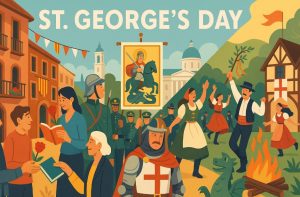St George’s Day, observed every year on 23rd April, is recognised as the national day of England.
Celebrated in honour of St George, the nation’s patron saint, the day has roots in medieval legend, Christian martyrdom, and English chivalric tradition.
Though his life details remain clouded by legend and symbolism, St George represents values of bravery, honour, and faith – qualities long cherished in English culture.
Despite changes in public engagement over time, the legacy of St George’s Day continues to resonate today.
From civic events in London to parades in Catalonia, his story transcends borders, offering a rich cultural narrative that blends faith, folklore, and national pride.
Why Did St George’s Day Originate?

St George’s Day has its origins in both Christian liturgical history and popular medieval mythology. George was a Roman soldier of Greek origin who served under Emperor Diocletian and was martyred for refusing to recant his Christian faith.
According to tradition, he was executed on 23rd April 303 AD, which became the day of his veneration.
The story of his martyrdom spread quickly across Christian communities, and by the early Middle Ages, churches and monasteries had adopted his story into their religious observances.
His popularity rose significantly during the Crusades when European soldiers and knights, inspired by his example of piety and courage, adopted him as a spiritual protector.
The legend of St George slaying a dragon emerged during this time, portraying him as a knight who saved a town and a princess from a fire-breathing beast.
While mythical in nature, this tale became the symbol of Christian virtue prevailing over evil.
Why is St George Considered England’s Patron Saint?
England has had several candidates for patron sainthood throughout history, including St Edmund the Martyr and St Cuthbert of Lindisfarne.
However, St George gained prominence during the reign of King Edward III in the 14th century.
Edward not only chose George as the patron of the newly founded Order of the Garter, the most prestigious order of English chivalry, but also encouraged his veneration among the nobility and the church.
His adoption as the national patron saint was partly symbolic he was not only a Christian martyr but also represented the ideals of knighthood and moral integrity.
The image of St George as a dragon slayer became an emblem of English resolve during periods of conflict, including the Hundred Years’ War, where soldiers would invoke his name on the battlefield.
Although George never lived in England, his legend served as a powerful unifying symbol, especially during times of war and political change. His image began to appear on coats of arms, church windows, and official regalia.
Why Did St George’s Day Become a National Celebration?

St George’s Day grew into a full-scale national feast day by the 15th century, when church synods in Canterbury and York formally elevated it to a “double major feast day.”
At that time, the celebration was as widely observed as Christmas. Businesses closed, churches held special masses, and communities organised feasts and processions in his honour.
The day’s importance was reinforced by the state and the church. Kings and nobles encouraged the celebration of George’s virtues, aligning them with national values.
Over time, festivities included tournaments, storytelling, and morality plays. Even everyday citizens took part through community gatherings and religious observances.
However, after the union of England and Scotland in 1707 and the rise of a unified British identity, the prominence of St George’s Day diminished.
It ceased to be a public holiday, and its religious observance waned. Nonetheless, the saint’s image never disappeared entirely and continued to be honoured in military, religious, and civic contexts.
Why Are There Traditions and Customs on St George’s Day?
The traditions surrounding St George’s Day reflect both medieval folklore and a deepening national identity.
The use of the St George’s Cross, a red cross on a white background, became widespread during the Crusades and was officially adopted by England in the 12th century.
Though modern celebrations are less extravagant than those of earlier centuries, certain customs have persisted or been revived, especially among cultural organisations and local councils.
Typical traditions include:
- Displaying the St George’s Cross on buildings, vehicles, and clothing
- Church services that highlight themes of courage and faith
- Community parades and pageants, often featuring reenactments of the dragon-slaying legend
- Performances of traditional English music and dance, including Morris dancing and folk songs
- School activities focusing on the history and symbolism of the day
These practices help preserve a connection to English heritage, especially among younger generations and diaspora communities.
Why is St George’s Day Still Observed in Modern Britain?

Despite being overlooked as a public holiday, St George’s Day is seeing a cultural revival.
Public figures, local governments, and heritage organisations have advocated for wider recognition of the day as a celebration of English identity and diversity.
One of the most prominent examples of this revival is the St George’s Day Festival at Trafalgar Square in London, organised by the Mayor of London.
St George’s Day London Event – 2025 Highlights
- Date: Monday, 21 April 2025
- Time: 12:00 pm to 6:00 pm
- Venue: Trafalgar Square, Westminster, London
- Admission: Free
The event promises an inclusive, family-friendly atmosphere featuring:
- Live music and stage acts from Harleymoon Kemp, Matilda Gracia, The Nigel Grice Jazz Collective, and others
- Traditional dance performances from the Belles of London City and Cut A Shine
- Interactive workshops, including Morris dancing, Easter bonnet crafting, and sea shanty sing-alongs
- Appearances from St George and his dragon, Pearly Kings and Queens, and street performers
A special family zone, hosted by Tootles & Nibs, offers child-friendly entertainment such as:
- Craft activities like the Trafalgar Flower Show
- The Silly Olympic Games and Hobby Horse Dressage
- Face painting, carousel rides, and photo stations
Accessibility & Support
- Wheelchair-accessible routes and viewing areas
- British Sign Language interpretation for stage shows
- Ear defenders and quiet zones for sensory-sensitive attendees
- Mobiloo accessible toilets with hoist and changing table facilities
This event reflects a modern vision of St George’s Day, one that welcomes all communities, celebrates England’s diversity, and connects citizens to their cultural heritage.
Why Does St George’s Day Hold Symbolism Today?
In an increasingly multicultural and globalised society, St George’s Day offers a focal point for discussing English identity in a modern context.
The day’s significance goes beyond medieval legend – it represents a continuity of values, from moral courage to cultural unity.
St George has also been associated with various groups and institutions, including:
- The Scout Movement, where he is the official patron saint
- The English military, where his name and emblem are still invoked
- Sporting events, particularly football, where fans proudly fly the St George’s flag
Although some critics argue for replacing St George due to his lack of direct connection with England, others advocate preserving him as a symbol of continuity and historical depth.
Why is St George’s Day Celebrated Outside the UK?

St George’s influence reaches far beyond England. He is the patron saint of multiple nations, regions, and cities, including:
- Catalonia and Aragon in Spain, where the day is marked by book and rose exchanges
- Portugal, where St George is revered as a protector of the nation
- Hungary, where mystical traditions and fertility rituals are tied to the day
- Georgia, where multiple feast days are dedicated to him
- Brazil, where his feast is marked with fireworks and dawn masses
Each region blends local customs with religious observance, creating diverse interpretations of the same figure.
Table: Comparison of Patron Saint Days in the UK
| Saint | Country | Date | Public Holiday | Key Traditions |
| St George | England | 23 April | No | Parades, flags, school events, and church services |
| St Andrew | Scotland | 30 November | Yes | Ceilidhs, saltire displays, cultural festivals |
| St David | Wales | 1 March | No | Leeks, daffodils, national dress, and concerts |
| St Patrick | Ireland | 17 March | Yes | Parades, green clothing, and global celebrations |
Conclusion: Why St George’s Day Still Matters?
St George’s Day is more than a celebration of an ancient figure. It is a reminder of the enduring stories and values that continue to shape English culture and identity.
Whether through church bells, music festivals, or family crafts, the day connects people to shared heritage while embracing modern diversity.
The 2025 Trafalgar Square event exemplifies how a historical celebration can be reimagined for today, inclusive, festive, and meaningful.
In an age where cultural landmarks are increasingly scrutinised or forgotten, St George’s Day invites us to reclaim tradition with openness and relevance.
FAQs About St George’s Day
What is the origin of St George’s story?
He was a Roman soldier martyred for his Christian faith around 303 AD. His legendary battle with a dragon became symbolic of good defeating evil.
Why is St George the patron saint of England?
Adopted during the medieval period by royal decree, his virtues aligned with the chivalric ideals of the time and offered a unifying symbol.
How is St George’s Day celebrated in London?
With festivals like the Trafalgar Square event, featuring live performances, crafts, traditional dancing, and inclusive family activities.
Is St George’s Day a public holiday in England?
Not currently, though there have been repeated calls and political proposals to make it one.
How has the celebration changed over time?
From major feasts in the Middle Ages to relative obscurity and now cultural revival, St George’s Day has seen many phases.
What countries besides England celebrate St George?
Portugal, Georgia, Spain (Catalonia and Aragon), Hungary, and Brazil, among others, all hold unique celebrations for St George.
Is the event at Trafalgar Square accessible?
Yes, with wheelchair access, sign language interpreters, accessible toilets, quiet zones, and stewards ready to assist all visitors.






